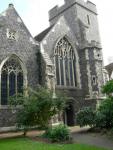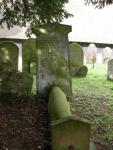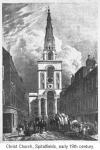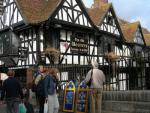Emily Rebecca Morris (1865 - 1936)
Mary Ann, Elizabeth, and Thomas Thorpe DELASAUX were the children of Thomas and Elizabeth. Elizabeth DELASAUX wrote her will as a widow in 1837; her death has not been found, but it must have occurred between 1837 and 1841 because her brief will was proved in February of that year. Elizabeth makes no mention of son Thomas Thorpe, who had already inherited from his father Thomas, or of her daughter Elizabeth who, presumably, was already dead. Instead, she leaves all monies, securities, plate, linen, china, clothes, jewellery and personal estate to her “dear daughter” Mary Ann DELASAUX. Mary Ann is also named as executrix along with Richard Minter Mount as co-executor. Elizabeth’s husband Thomas had died in 1836, at the age of 83, his will written in July and proved in November of that year. Thomas DELASAUX Esq., alderman of the City of Canterbury, was a rich silk weaver, one of the several children of Pierre DELASAUX and Elizabeth DUTHOIT. He directs that he is to be interred in the family tomb in the parish church of St Margaret and that a headstone is to be erected (unfortunately, neither appears to have survived, and St Margaret’s no longer functions as a separate parish church).
His wife Elizabeth is to inherit his personal effects together with the investment income from the residue of his estate. His widowed daughter Elizabeth SIMMONDS (husband Joseph had died in 1831) is granted a weekly allowance, and his other daughter Mary Ann is named as co-executrix with his wife Elizabeth. Son Thomas Thorpe DELASAUX is to be paid £2,000 at the end of 6 months (equivalent to about £100,000 today) while grandson Joseph DelaSaux SIMMONDS, one of the sons of his daughter Elizabeth, is to be paid £300 (modern equivalent about £15,000); granddaughter Mary Ann SIMMONDS, who had married in 1834, is to be paid £200 (modern equivalent about £10,000) immediately on his decease. Thomas’s unmarried daughter Mary Ann, following the death of his wife Elizabeth, is to receive £3,000 (modern equivalent about £150,000) on trust to be invested in government securities or whatever Mary Ann deems appropriate, always provided that sister Elizabeth is well looked after. He further directs that this capital sum is to remain intact and the income there from to be for the equal benefit of Elizabeth’s four children, there being two further sons, James Stock and Thomas SIMMONDS. The residue of his estate is willed to his wife for life and then to daughter Mary Ann, the residue including all freehold and leasehold properties together with the property in the parish of St Mildred left to him by his late godmother, Mrs Jane Hatton, widow, and a further property purchased by him from another widow who is protected during her lifetime by a specific bequest.
Essentially, therefore, Thomas does what one would expect him to do: provide for his wife whom he expects to outlive him, then for his three children, particularly maiden daughter Mary Ann, then for his four grandchildren. By any standards Thomas DELASAUX was a wealthy man, a business man who achieved status in Canterbury and left his dependants very well provided for. On the evidence of her will some 20 years later, his daughter Mary Ann was an equally shrewd business woman who managed her inherited fortune most efficiently for her own benefit and that of her dependants. William ELLIS of Somerset doubtless married for love Mary Ann SIMMONDS of Canterbury; but it has to be said that he did well, as a shoemaker, to attract such an heiress. Given that Mary Ann inherited a considerable lump sum just two years after her marriage in 1834 and that, 18 years later, she did very well from her aunt’s will, it seems odd that the ELLIS family does not appear to have been more prosperous.
Wills were also left by Thomas’s spinster sisters Mary and Jane. Mary, born 1756, wrote her will in 1822, proved 1830; after two cash bequests to spinster niece Elizabeth FENNER and to nephew and godson Thomas Thorpe DELASAUX, she leaves the remainder of her obviously considerable estate, comprising land and properties as well as personal possessions, to her older sister Jane who is also named sole executrix. As well as being older than her sister, Jane outlived Mary, dying in 1837-1838, aged almost 90. Jane also concentrates her bequests on spinster niece Elizabeth FENNER who is gifted “messuages, lands, tenements and heridataments” in addition to £1,000; Thomas Thorpe DELASAUX, Mary’s other main beneficiary, gets £800 and James Stock SIMMONDS, son of niece Elizabeth SIMMONDS, £50. Elizabeth FENNER inherits the remainder of her aunt’s estate, and she and a good friend of Jane, William Drury Furley, are named executors, entrusted with the investment of £1,600 in 3 ½% annuities for the benefit of the children of nephew Thomas Thorpe DELASAUX. Jane’s will, dated 1st of November 1836, was proved in London in June 1838.
Thomas DELASAUX and his five siblings (two brothers, three sisters) were the children of Peter DELASAUX and Elizabeth DUTHOIT. Peter DELASAUX, gentleman of the City of Canterbury, was baptised the 1st of May 1715 and on the 4th of August 1743 he married Elizabeth DUTHOIT at Christchurch Stepney, Spitalfields. Elizabeth was the daughter of Peter DUTHOIT the Elder of London and St Paul Canterbury whose will, written in 1757 and proved in 1774, names a second daughter Jane and five sons.
Peter DUTHOIT had married Jane HESMAN on the 27th of May 1715 at Stepney St Dunstan, their daughter Elizabeth being baptised on the 3rd of February 1717. The marriage of Peter DELASAUX and Elizabeth DUTHOIT brought together two wealthy merchant families of Huguenot origin.
Peter DELASAUX’s will, written in 1797/1803 and proved 1804, is an admirable mix of outright generosity and circumspect family management. He provides for his unmarried daughters Jane and Mary by gifting them outright his several properties in the parish of St Margaret Canterbury. Son Thomas is to inherit £530 (modern equivalent about £30,000) so that he can repay a bond he has taken out for £630 together with the accrued interest and the balance of £100. Thomas also gets his father’s personal clothes and linen. Peter also makes provision for his daughter Elizabeth and her husband Rest FENNER and any children they might have. Interestingly, he makes this provision through a trust in the hands of brother James, son Thomas, and daughters Jane and Mary, thus keeping the capital sum of the trust within the family. £430 (equivalent to about £25,000) is to be invested by the trustees for the benefit of the FENNER family, the benefit only reverting back to the DELASAUX trustees in the event of there being no FENNER survivors. Peter similarly provides for the children of his son Peter who predeceased his father. Peter, born in 1744, notary public proctor of the Court, married Elizabeth Gunsley AYERST, daughter of Robert Gunsley AYERST, rector of St Peter Canterbury, in June 1766 in Elizabeth’s church. They had four children, Robert Gunsley, baptised the 2nd of February 1770 at Canterbury St Alphege, Elizabeth Gunsley who died in infancy, Mary Ann, baptised the 7th of August 1775, and Esther Elizabeth Gunsley, baptised the 26th of August 1768, who married William Henry KEMP in 1793 at Canterbury St Peter; they all benefit from their grandfather’s will through the income arising from £100 invested in South Sea funds. Abraham and Peter THORPE, sons of his deceased sister Mary, get a token 5 guineas each in recognition of the fact that their father is still alive. Brother James is gifted £20 and is named executor along with his sisters Jane, Mary, and Elizabeth FENNER. A codicil added some six years later reduces each of the bequests to Thomas and to Robert and Elizabeth FENNER to, respectively, £430 and £330. The will was proved in 1804, administration being granted to the four previously named executors.
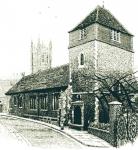
A drawing of the church of St Alphege where in 1575 the early refugees were first granted rights to hold services – before transferring one year later to the Cathedral crypt.
Peter DELASAUX, brother James, and sisters Mary, Elizabeth and Ann were the offspring of Peter/Pierre DELASAUX and Elizabeth BATAILLE. Peter DELASAUX the Elder of Canterbury, silk weaver, was the paternal great grandfather of Elizabeth SIMMONDS; his will was written in 1753, proved in 1756. Peter leaves his son James £30 to be paid on marriage or on his setting up in business. His “dear wife” Elizabeth inherits the income from the residue of his estate with the proviso that she can draw on the capital if the income alone is insufficient to her needs. Following the death of his wife, Peter’s estate is to be split equally between his surviving children. Son Peter or his children receive one quarter of the residue; daughter Mary and son-in-law Peter THORPE, and then their children, get a second quarter; and the third and fourth quarters go to son James and his heirs and to daughter Ann and her heirs. If Ann dies before her husband Christopher SIMPSON, her portion is to go to her child or children; but if there are none, or none reaches maturity, then the share is to revert to the other three legatees equally. Ann is also to inherit the remainder of her father’s personal effects; but the wording of the bequest is emphatic that they must go to her directly for “her own private and separate use”. Peter further secures this legacy by naming his wife Elizabeth, sons Peter and James, and Peter and Mary THORPE, as executors and executrices. All previous wills are revoked, and the will was proved on the 25th of June 1756 before his wife Elizabeth and sons Peter and James.
It seems very noticeable, therefore, that Peter makes a distinction between his son-in-law Peter THORPE, who is treated as if he were Peter’s own son, and his son-in-law Christopher SIMPSON, who is deliberately excluded from the will and prevented from getting his hands on his wife’s inheritance. We cannot be sure of the reason for this distinction. It could simply be that Ann, some nine years younger than Mary and perhaps only recently married, had a husband whom Peter felt he did not know well enough to trust to the same degree that he trusted Peter THORPE. In any case, Peter and Mary THORPE already had children whom their grandfather would have wanted to benefit from his will. The very precise wording of his will, however, suggests that the testator did not like, or approve of, or trust his son-in-law Christopher SIMPSON and so tried his utmost to protect the interests of his daughter Ann and any child she might have.
These wealthy silk weavers and merchants almost inevitably became prominent citizens. Peter DELASAUX the Elder was church deacon in 1722, 1733, and 1743, while his son Peter succeeded him in this position in 1754. Hasted’s History of Kent 1793 lists Thomas DELASAUX, father of Elizabeth SIMMONDS, as Mayor of Canterbury in 1791 and 1801 and as alderman of the City for many years; and the same Thomas figures prominently in the records of Canterbury freemen. Thomas’s father, Peter, silk weaver, became a freeman in 1761, as did Peter’s brother James in the same year, possibly as an enrolled apprentice, and again in 1768 when he might have completed his apprenticeship. The record lists Thomas, son of silk weaver Peter and his apprentice, as an enrolled apprentice in 1768 and as silk weaver in his own right in 1778.
Thomas is again listed in 1809 as an esquire and alderman. Thomas’s son James, gentleman, became a freeman of the City in 1812; but James, baptised the 27th of September 1790 at Canterbury St Mary, predeceased his father who does not mention him in his will written and proved in 1836. James was buried on the 20th of January 1816 at Canterbury St Mildred, aged just 25; he was apparently unmarried and died without issue. Thomas’s other son, Thomas Thorpe DELASAUX, gentleman of Harbledown, became a freeman in 1818; he was City Sheriff in 1837 and in two subsequent years, and served as coroner of Kent for a staggering 64 years and of Canterbury for 45 years. The freeman privilege extended through Thomas’s daughter Elizabeth to his son-in-law Joseph SIMMONDS, a brickmaker, who was admitted freeman in 1809 shortly after his marriage to Elizabeth DELASAUX. Joseph SIMMONDS possibly had a brother Stephen, born 1775, whose wife was named Mary and daughter Marianne. Stephen was a cornfactor who became a freeman by purchase in 1817. Joseph and Stephen were likely to have been the sons of John and Ruth SIMMONDS who had a further six children between 1772 and 1790.


